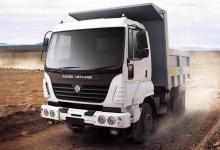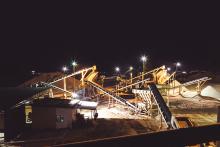The Indian cement sector’s ambitious plans involve both expanding existing site production and setting up newer facilities through major capital expenditure. The moves are being fuelled by projected rising demand for cement from India’s roads and airport infrastructure sector.
According to the estimates of the Indian cement producers, present national production capacity is between 300-300 million tonnes. Based on companies’ ongoing projects, an additional 400 million tonnes of cement production capacity is set to be added over the next 18 months. Longer term, another 600 million tonnes of capacity is due to be added in the next three-five years.
Major cement companies which are set to implement large-scale output increase proposals include UltraTech Cement. The company is increasing its production capabilities in Karnataka and Chhattisgarh, in South and Central India respectively, and in Rajasthan, North India. A significant production volume increase is also in the pipeline for ACC- Lafarge in Maharashtra, Western India, while enlarged cement production capacity works by Ambuja Cements, JK cements and Shree Cements in Rajasthan are also underway. Furthermore, North India-based cement-producing major Wonder Cements is undertaking a significant cement capacity increase at its Rajasthan unit. Finally, South India-based Ramco will soon be undertaking key capacity expansions at its sites in Kerala and Tamil Nadu.
The great Indian cement industry production expansion includes further development of companies’ limestone mining sites, with new grinding facilities created and higher capacity crushing units installed, supported by newer conveying systems. Higher production throughput made possible by capacity expansions has created an urgent need for higher capacity rigid dump trucks (RDTs). This is already visible as cement business bosses aim to haul higher volumes of raw materials thanks to faster cycle times due to reduced production downtime. Maximum production uptime is key to lowering the production cost per tonne, enabling them to remain commercially viable in the highly competitive Indian cement industry.
Vijay Kumar Mali, senior vice president UltraTech Cement, said: “The heavier loads to cater for the expanded production facilities have made it necessary to deploy higher capacities of rigid dump trucks. However, more than that, it is the rising safety requirements based on newer regulations that have made it imperative to use higher capacity 40, 50, 60 and 100-tonne models. The recent directives of the Directorate General of Mining Safety in India (DGMS) state that limestone mines belonging to cement plants that feature higher levels of undulation and steep gradients will have to mandatorily use higher capacity off-highway RDTs instead of conventional-size RDTs.”
DGMS’s new directives came in after several fatal accidents at cement industry sites involving on-highway-sized haul trucks with faulty brakes.
Mali continued: “The heavier RDTs feature multiple braking arrangements. Furthermore, the trucks are ROPS -[roll over protection system] and FOPS- [falling object protective structures] compliant. This makes them safer to use on steep gradients.” A further safety feature of larger RDTs is their bigger-diameter tyres.
Cement producers have also gained from higher capacity RDTs’ longer lifecycle compared to smaller rigid haulers.
“In many cases, the 60-tonne 567kw engine Cat 773E RDTs we are using at our Ravivyas facility has clocked close to 85% availability running between 20,000 to 75,000 hours,” highlighted Mali. “Usage of the higher capacity trucks has prevented overcrowding of the sites, which can be a feature of running a fleet of smaller capacity RDTs. Besides, it has made operations safer for us.”
According to senior plant managers from Rajshree and Ambuja Cements, higher capacity Caterpillar RDTs have delivered higher levels of fuel efficiency and greater tractive ability, allowing them to comfortably cope with steep and sometimes slippery haul-road surfaces.
Rajshree Cements is using nine 100-tonne 567kW Cat 777Es at its facility, while 13 50-tonne 480kW Cat 772Gs have been used by Ambuja Cements to haul limestone boulders to the grizzly feeding unit. Meanwhile, 12 40-tonne Cat 770, 283kW are also being utilised by UltraTech Cement.
However, despite Caterpillar RDTs’ popularity with some cement industry heavyweights, a spokesman for the manufacturer’s India dealer, Gainwell, said that the short turning radius at limestone mining sites was deterring plant owners from acquiring 60-tonne-plus capacity RDTs in a “major way”.
Indian truck manufacturing major Ashok Leyland has a considerable presence in the cement and quarry industry. It has recently delivered 14 new Captain 2523 6x4 rigid dump trucks to the limestone crushing facility of JK Lakshmi Cement. The trucks transport the limestone boulders six kilometres from the firm’s Garoli captive mines in Udaipur, Rajasthan, to the mineral processing facility at the plant’s Udaipur Cement Works.
D.S Charan, senior plant manager at Udaipur Cement Works, said: “The Captain series trucks have delivered lower operating costs and faster cycle time enabling the plants to run very efficiently.”
Arindam Das, head – Construction & Mining Vertical, Ashok Leyland, said: “The Captain series trucks come with BS 4-compliant engines, meeting the new Indian emission norms. Lower cost of operation is delivered in a major way by iEGR [intelligent exhaust gas recirculation] technology working on the engines, compared to SCR [selective catalytic reduction] technology. With iEGR technology in place, there is no requirement for AdBlue.” Ashok Leyland also manufactures its own H-Series common rail engines.
For 35-tonne-class RDTs, Ashok Leyland offers the CT3118 with 18m³ body, powered by a 134kW engine, the U3123 with 22m³ body and an air-conditioned cabin, and the 171kW-engine-powered Captain 3123 with 22m³ body and a “world-class” cabin. These products are said to be ideally suited to the needs of customers looking for premium or value for money trucks. Ashok Leyland also recently introduced the N 3532 RDT. The new rigid hauler has a 239kW engine and a 19m³ body.
“The new higher capacity [domestic rigid dump truck] solutions come with lower initial purchase and operating costs than those offered by international RDT manufacturers operating in India’s bulk heavy-haul segment,” said Das.








